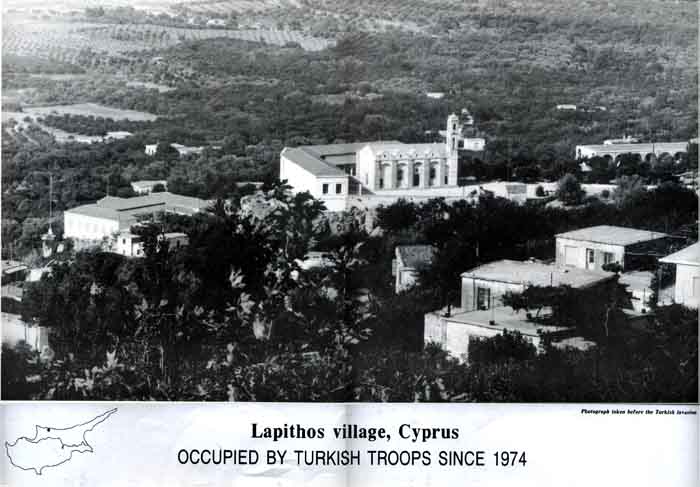In 1925, Angeliki was born in the humid Cypriot month of September. Sitting several hundred metres above the sea and perched at the foot of the Pentadhaktylos range, Lapithos gave some refuge from the thick Mediterranean heat patrolling the coastline.
Angeliki was born into a family of Greek heritage. Her father worked as a builder and her mother at home as a seamstress. Angeliki soon had 3 younger sisters and as the oldest helped her mother at home. It was in the family kitchen where she completed her mother’s apprenticeship in Greek Cypriot cooking. She was essentially responsible for preparing the family’s meals, and despite the workload from home completed her secondary schooling.
Angeliki’s Lapithos roots are thousands of years old. Her Greek ancestors settled in Cyprus in 750BC and Lapithos was one of their first established kingdoms. Since her village’s original inhabitants it has seen a long and complicated list of residents. Yet three players alone have clearly had the greatest impact in Cyprus’ modern history.
In 1571 the Ottoman juggernaut rolled into Cyprus bringing with it 20,000 new Turkish settlers. The 300 years of Ottoman rule came to an end as the Russo-Anglo battle for empires took prominence on the world stage. In 1878 Turkey and Britain signed an agreement allowing sovereignty to reside with the Ottoman Sultan while giving administrative rights to the British. The English were eager to utilize Cyprus for its strategic position in relation to Russia. Yet in 1914 as Ottomans and British became WWI enemies the agreement was disbanded and London annexed Cyprus.
Soon after WWI the Greek Cypriot desire for a union with Greece (enosis) steadily gathered importance. This was something the British were seen as standing in the way of. The enthusiasm for unity manifested itself in growing dissent towards the English. Pro-enosis riots broke out in 1931 during which the Government House was torched in Nicosia. At this stage, the Turks constituted a 20% minority of the island and were calling for partition (Taksim) fearful of being Hellenised.
The British Governor turned to a tactic of suppression in the 1930’s. In an endeavour to prevent local interest in politics, limitations were introduced on the administration of Greek schools and unionization was prohibited. These measures continued until the second world war when over 30,000 Cypriots joined the British forces.
A 1951 referendum showed 97% support amongst Greek Cypriots for enosis. The UN accepted the petition and brought the demands to an international level. Yet given the strong Turkish community, union with Greece was repeatedly rejected by London.
As anti-British sentiment bubbled away, a guerrilla group, EOKA (Ethniki Organosis Kyprion Agoniston - National Organisation of Cypriot Fighters) materialized and with it the next chapter of unrest. From 1955 to 1959 the EOKA launched attacks on British administration and military. Many young Lapithotes were trained in guerrilla tactics and participated in what was seen as a struggle for liberation. 371 British servicemen lost their lives over these four years.
It was in this climate of unrest that Angeliki took leave from her Cypriot homeland. Her sister Sophia had already migrated to Australia with Angeliki’s new brother-in-law as a sponsor she left Lapithos behind her.
History after leaving Lapithos
The 1950’s saw the Turkish community gradually drawn into the violence. An enosis was an alarming prospect for the Turkish Cypriots, something the Turkish government was well aware of. Turkish-Greek hostility evolved into a new phase as Greece recognized that Turkey was a serious player in Cyprus, and also that enosis was unrealistic. In 1959, Turkish, Greek and British representatives met in Zurich and agreed upon a Cypriot constitution giving administrative rights to both parties. 1960 saw the birth of the Republic of Cyprus and a brief calm before the storm. The leader of the EOKA became the country’s first president. The constitution clearly ruled against enosis or taksim, union or partition.
Greeks argued that the constitution gave Turks parliamentary rights that disrupted efficient government. There were moves to force out the Turkish representation in parliament. With these developments came the next wave of unrest. In 1964, with violence erupting and all Turkish members out of government, most Turkish Cypriots had fled to enclaves making up 3% of the country. At this point a UN peacekeeping force was deployed to maintain law and order.
In July 1974, the President was overthrown by a coup sponsored by Athens, citing the reasons as the ‘President’s alleged communist leanings and abandonment of enosis’. Turkey claimed that the constitution was now void and in a bid to protect the Turkish Cypriot population invaded Northern Cyprus.
Turkish military took control of 38% of the island. 200,000 Greek Cypriots fled to the south and 60,000 Turkish Cypriots were transferred to the North. Turkey relocated at least 40,000 people from the mainland to equal the Cypriot demographics.
In 1983 Northern Cyprus declared itself the Turkish Republic of Northern Cyprus, an entity which is recognized only by Turkey. The UN rejects the declaration calling it ‘legally invalid’ and has enforced an international embargo.
In 2003 the ‘Green Line’ which separates North and South was opened with conditions. This allowed Cypriots to cross and see their land and family for the first time in almost 30 years. In 2004 Cyprus was accepted into the EU. UN peacekeepers are still stationed along the border. Northern Cyprus is essentially Turkish and the south Greek.




0 comments:
Post a Comment